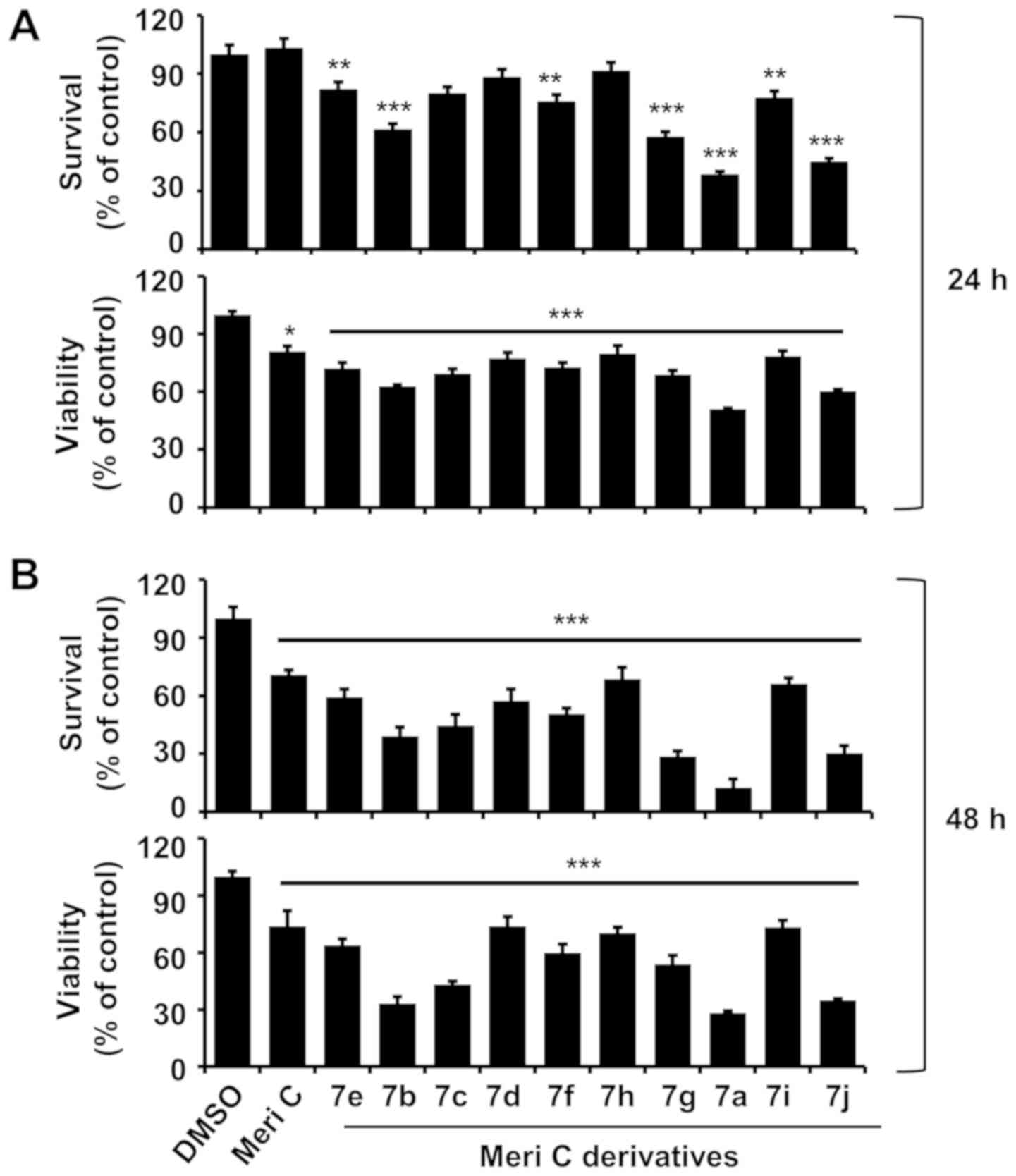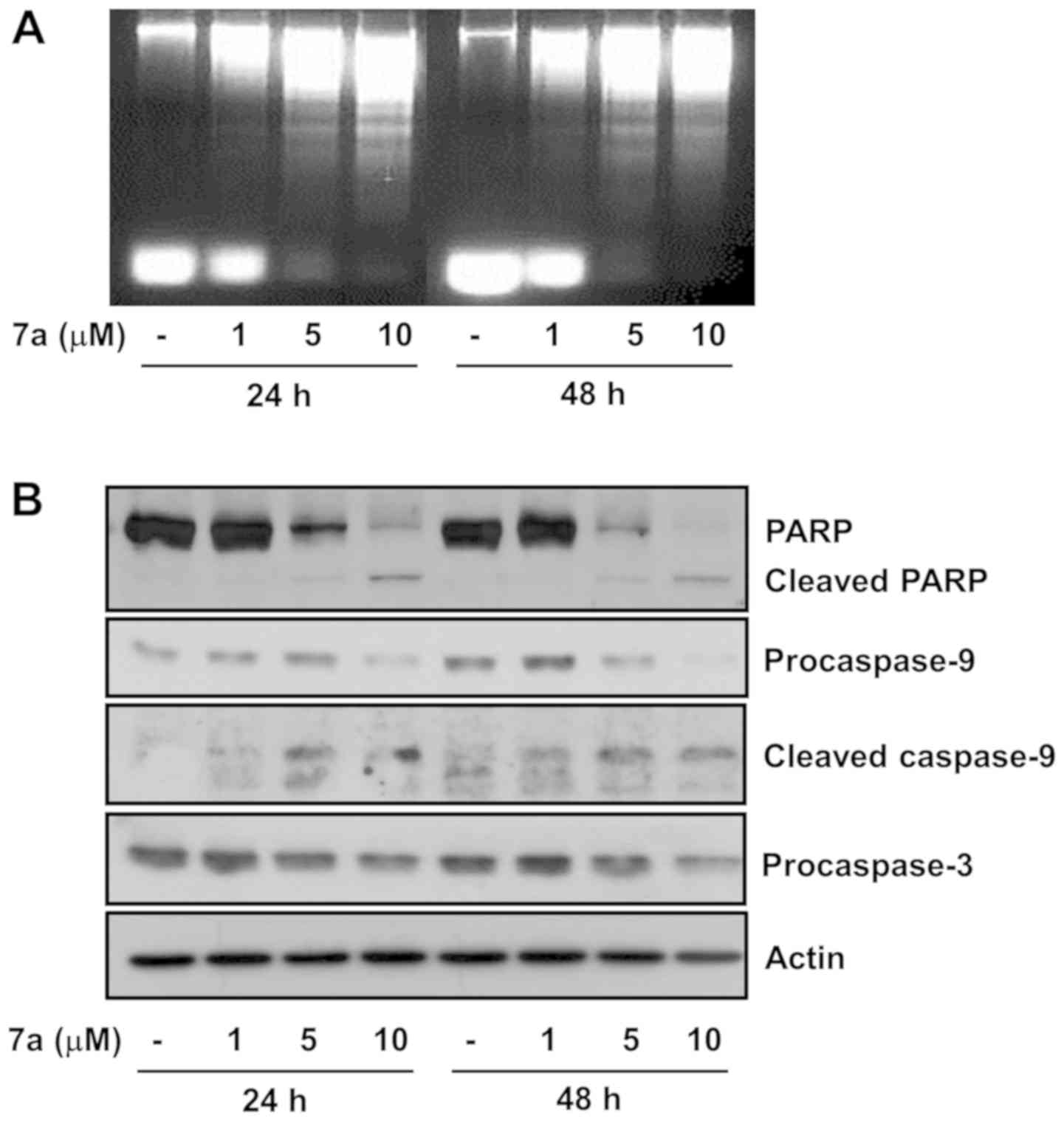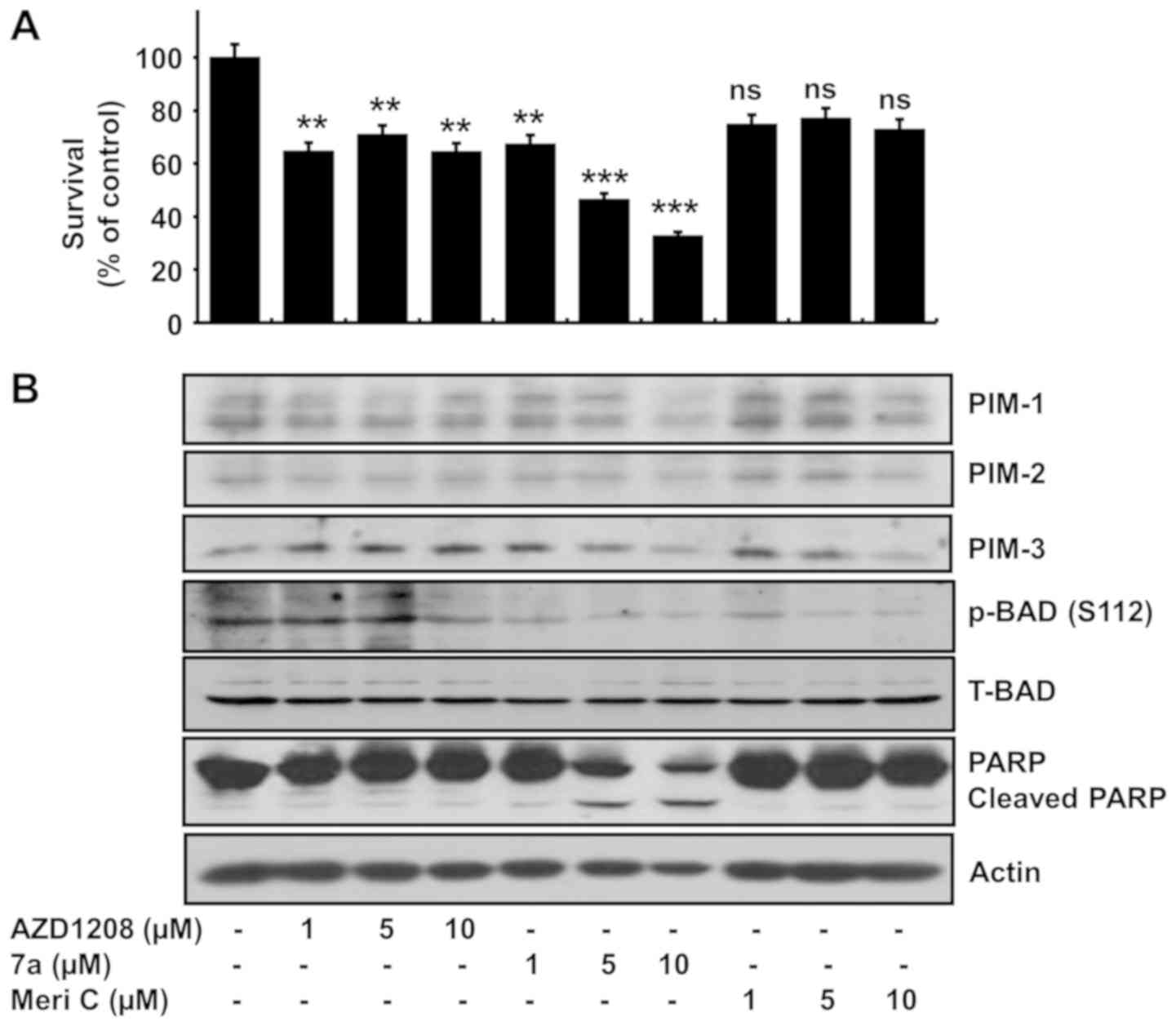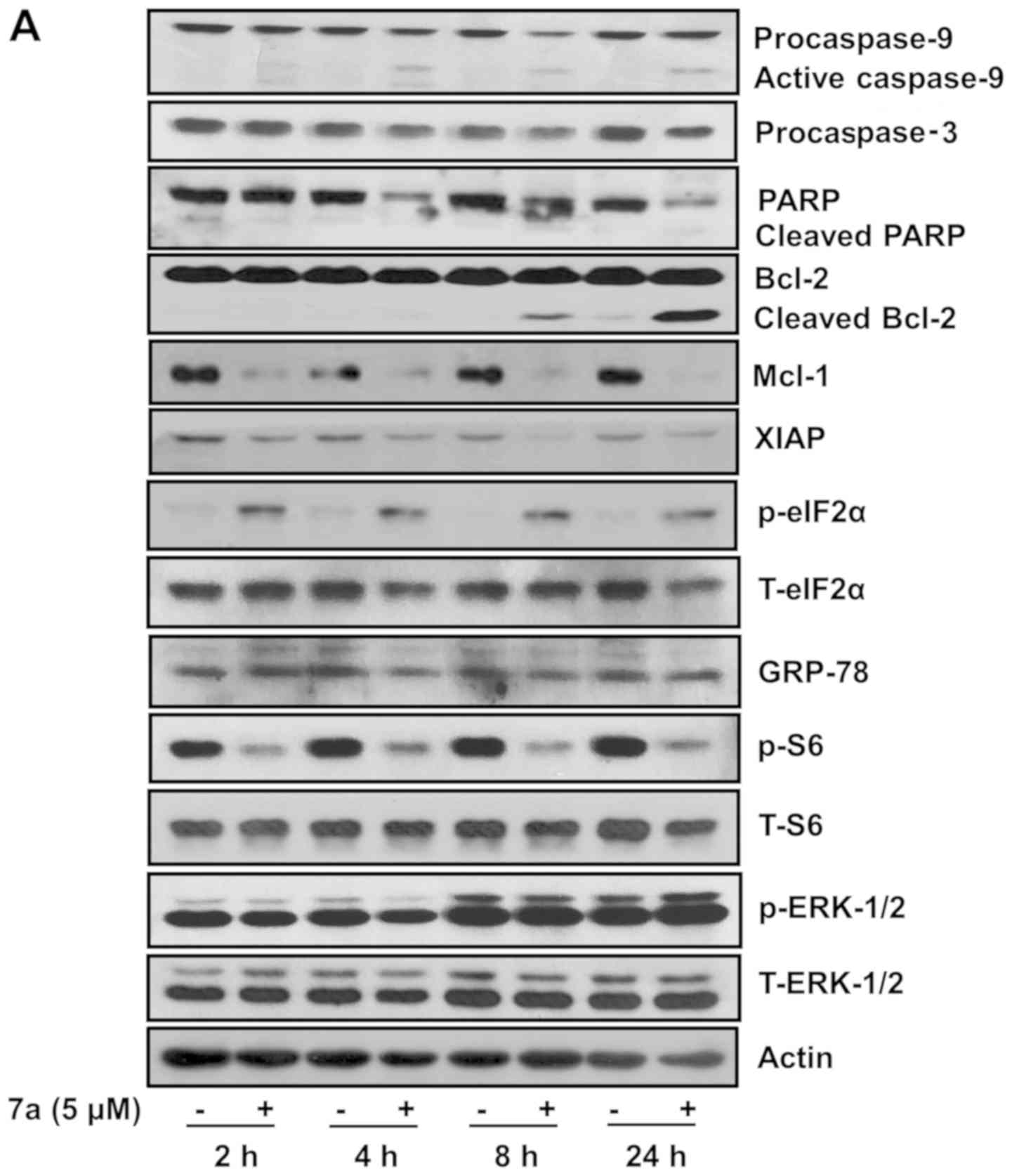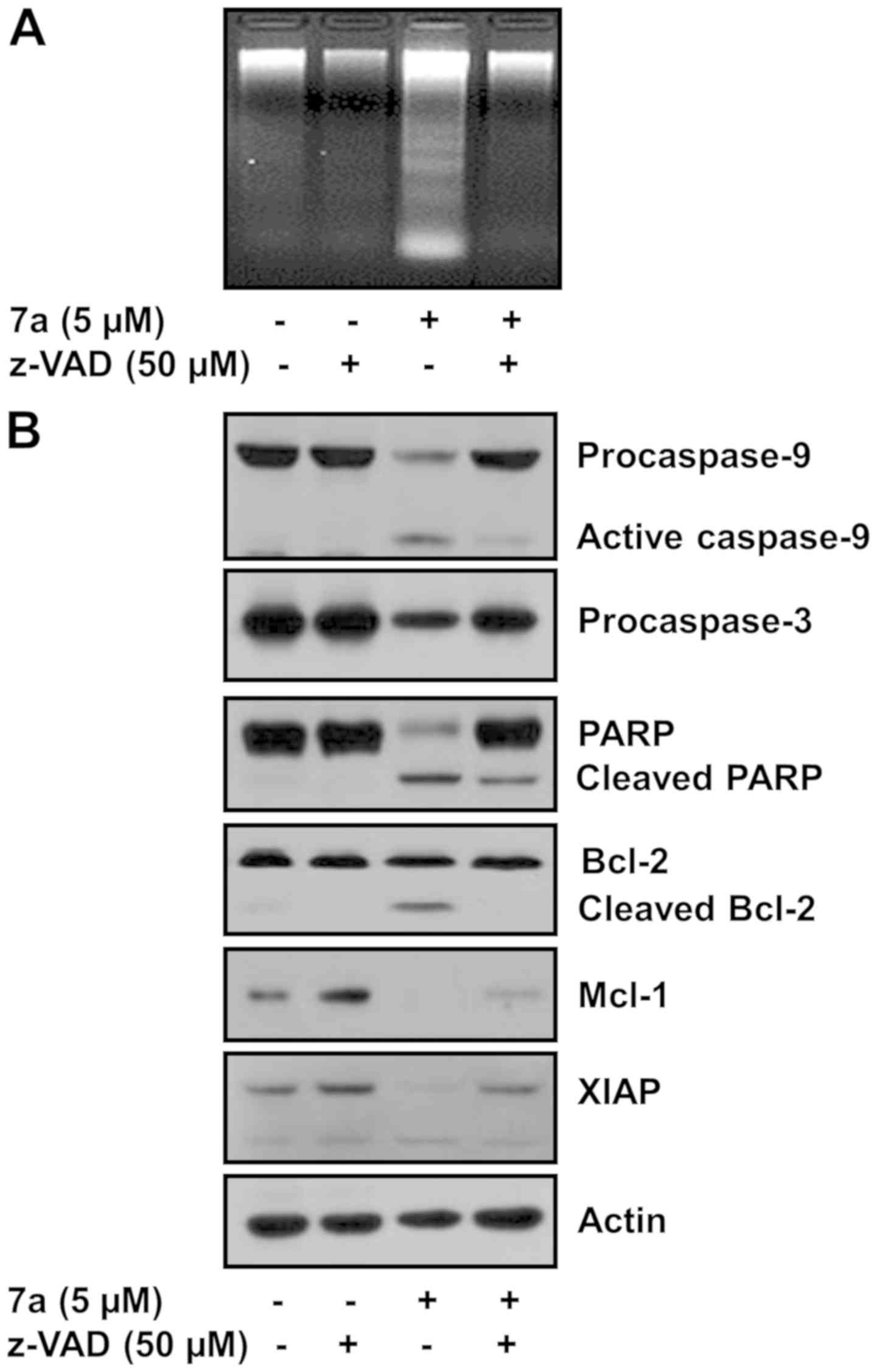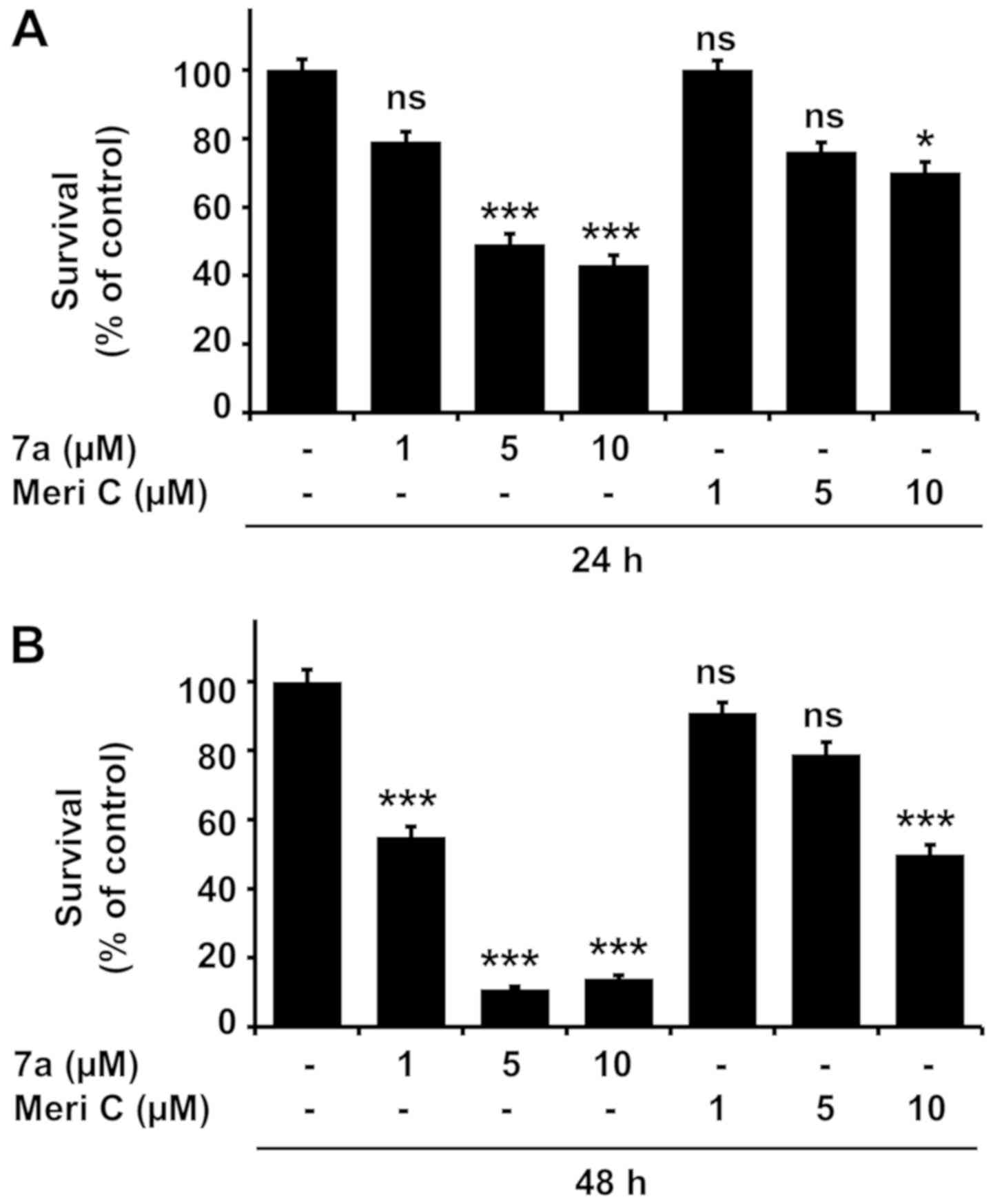|
1
|
Kornblau SM, Tibes R, Qiu YH, Chen W,
Kantarjian HM, Andreeff M, Coombes KR and Mills GB: Functional
proteomic profiling of AML predicts response and survival. Blood.
113:154–164. 2009. View Article : Google Scholar
|
|
2
|
Short NJ, Rytting ME and Cortes JE: Acute
myeloid leukaemia. Lancet. 392:593–606. 2018. View Article : Google Scholar : PubMed/NCBI
|
|
3
|
National Cancer Institute: Cancer Stat
Facts: Leukemia. https://seer.cancer.gov/statfacts/html/leuks.html
Accessed March 2, 2019.
|
|
4
|
Ossenkoppele G and Löwenberg B: How I
treat the older patient with acute myeloid leukemia. Blood.
125:767–774. 2015. View Article : Google Scholar
|
|
5
|
Wyllie AH, Kerr JF and Currie AR: Cell
death: The significance of apoptosis. Int Rev Cytol. 68:251–306.
1980. View Article : Google Scholar : PubMed/NCBI
|
|
6
|
Chen Q, Kang J and Fu C: The independence
of and associations among apoptosis, autophagy, and necrosis.
Signal Transduct Target Ther. 3:182018. View Article : Google Scholar : PubMed/NCBI
|
|
7
|
Cohen GM: Caspases: The executioners of
apoptosis. Biochem J. 326:1–16. 1997. View Article : Google Scholar : PubMed/NCBI
|
|
8
|
Deveraux QL and Reed JC: IAP family
proteins--suppressors of apoptosis. Genes Dev. 13:239–252. 1999.
View Article : Google Scholar : PubMed/NCBI
|
|
9
|
Kale J, Osterlund EJ and Andrews DW: BCL-2
family proteins: Changing partners in the dance towards death. Cell
Death Differ. 25:65–80. 2018. View Article : Google Scholar : PubMed/NCBI
|
|
10
|
Jang BC, Paik JH, Jeong HY, Oh HJ, Park
JW, Kwon TK, Song DK, Park JG, Kim SP, Bae JH, et al: Leptomycin
B-induced apoptosis is mediated through caspase activation and
down-regulation of Mcl-1 and XIAP expression, but not through the
generation of ROS in U937 leukemia cells. Biochem Pharmacol.
68:263–274. 2004. View Article : Google Scholar : PubMed/NCBI
|
|
11
|
Rao J, Xu DR, Zheng FM, Long ZJ, Huang SS,
Wu X, Zhou WH, Huang RW and Liu Q: Curcumin reduces expression of
Bcl-2, leading to apoptosis in daunorubicin-insensitive CD34+ acute
myeloid leukemia cell lines and primary sorted CD34+ acute myeloid
leukemia cells. J Transl Med. 9:712011. View Article : Google Scholar : PubMed/NCBI
|
|
12
|
Kitada S, Zapata JM, Andreeff M and Reed
JC: Protein kinase inhibitors flavopiridol and
7-hydroxy-staurosporine down-regulate antiapoptosis proteins in
B-cell chronic lymphocytic leukemia. Blood. 96:393–397. 2000.
View Article : Google Scholar : PubMed/NCBI
|
|
13
|
Luedtke DA, Niu X, Pan Y, Zhao J, Liu S,
Edwards H, Chen K, Lin H, Taub JW and Ge Y: Inhibition of Mcl-1
enhances cell death induced by the Bcl-2-selective inhibitor
ABT-199 in acute myeloid leukemia cells. Signal Transduct Target
Ther. 2:170122017. View Article : Google Scholar : PubMed/NCBI
|
|
14
|
Nawijn MC, Alendar A and Berns A: For
better or for worse: The role of Pim oncogenes in tumorigenesis.
Nat Rev Cancer. 11:23–34. 2011. View
Article : Google Scholar
|
|
15
|
Decker S, Finter J, Forde AJ, Kissel S,
Schwaller J, Mack TS, Kuhn A, Gray N, Follo M, Jumaa H, et al: PIM
kinases are essential for chronic lymphocytic leukemia cell
survival (PIM2/3) and CXCR4-mediated microenvironmental
interactions (PIM1). Mol Cancer Ther. 13:1231–1245. 2014.
View Article : Google Scholar : PubMed/NCBI
|
|
16
|
Lu J, Zavorotinskaya T, Dai Y, Niu XH,
Castillo J, Sim J, Yu J, Wang Y, Langowski JL, Holash J, et al:
Pim2 is required for maintaining multiple myeloma cell growth
through modulating TSC2 phosphorylation. Blood. 122:1610–1620.
2013. View Article : Google Scholar : PubMed/NCBI
|
|
17
|
Gómez-Abad C, Pisonero H, Blanco-Aparicio
C, Roncador G, González-Menchén A, Martinez-Climent JA, Mata E,
Rodríguez ME, Muñoz-González G, Sánchez-Beato M, et al: PIM2
inhibition as a rational therapeutic approach in B-cell lymphoma.
Blood. 118:5517–5527. 2011. View Article : Google Scholar : PubMed/NCBI
|
|
18
|
Guo S, Mao X, Chen J, Huang B, Jin C, Xu Z
and Qiu S: Overexpression of Pim-1 in bladder cancer. J Exp Clin
Cancer Res. 29:1612010. View Article : Google Scholar : PubMed/NCBI
|
|
19
|
Wang J, Anderson PD, Luo W, Gius D, Roh M
and Abdulkadir SA: Pim1 kinase is required to maintain
tumorigenicity in MYC-expressing prostate cancer cells. Oncogene.
31:1794–1803. 2012. View Article : Google Scholar
|
|
20
|
Keane NA, Reidy M, Natoni A, Raab MS and
O'Dwyer M: Targeting the Pim kinases in multiple myeloma. Blood
Cancer J. 5:e3252015. View Article : Google Scholar : PubMed/NCBI
|
|
21
|
Yadav AK, Kumar V, Bailey DB and Jang BC:
AZD1208, a Pan-Pim Kinase Inhibitor, Has Anti-Growth Effect on
93T449 Human Liposarcoma Cells via Control of the Expression and
Phosphorylation of Pim-3, mTOR, 4EBP-1, S6, STAT-3 and AMPK. Int J
Mol Sci. 20:22019. View Article : Google Scholar
|
|
22
|
Cervantes-Gomez F, Chen LS, Orlowski RZ
and Gandhi V: Biological effects of the Pim kinase inhibitor,
SGI-1776, in multiple myeloma. Clin Lymphoma Myeloma Leuk. 13(Suppl
2): S317–S329. 2013. View Article : Google Scholar : PubMed/NCBI
|
|
23
|
Gompel M, Leost M, De Kier Joffe EB,
Puricelli L, Franco LH, Palermo J and Meijer L: Meridianins, a new
family of protein kinase inhibitors isolated from the ascidian
Aplidium meridianum. Bioorg Med Chem Lett. 14:1703–1707. 2004.
View Article : Google Scholar : PubMed/NCBI
|
|
24
|
Bharate SB, Yadav RR, Battula S and
Vishwakarma RA: Meridianins: Marine-derived potent kinase
inhibitors. Mini Rev Med Chem. 12:618–631. 2012. View Article : Google Scholar : PubMed/NCBI
|
|
25
|
Giraud F, Alves G, Debiton E, Nauton L,
Théry V, Durieu E, Ferandin Y, Lozach O, Meijer L, Anizon F, et al:
Synthesis, protein kinase inhibitory potencies, and in vitro
antiproliferative activities of meridianin derivatives. J Med Chem.
54:4474–4489. 2011. View Article : Google Scholar : PubMed/NCBI
|
|
26
|
Radwan MA and El-Sherbiny M: Synthesis and
antitumor activity of indolylpyrimidines: Marine natural product
meridianin D analogues. Bioorg Med Chem. 15:1206–1211. 2007.
View Article : Google Scholar
|
|
27
|
More KN, Jang HW, Hong VS and Lee J: Pim
kinase inhibitory and antiproliferative activity of a novel series
of meridianin C derivatives. Bioorg Med Chem Lett. 24:2424–2428.
2014. View Article : Google Scholar : PubMed/NCBI
|
|
28
|
Park NS, Park YK, Ramalingam M, Yadav AK,
Cho HR, Hong VS, More KN, Bae JH, Bishop-Bailey D, Kano J, et al:
Meridianin C inhibits the growth of YD-10B human tongue cancer
cells through macropinocytosis and the down-regulation of
Dickkopf-related protein-3. J Cell Mol Med. 22:5833–5846. 2018.
View Article : Google Scholar : PubMed/NCBI
|
|
29
|
Drexler HG, MacLeod RA and Uphoff CC:
Leukemia cell lines: In vitro models for the study of Philadelphia
chromosome-positive leukemia. Leuk Res. 23:207–215. 1999.PubMed/NCBI
|
|
30
|
Meshinchi S and Appelbaum FR: Structural
and functional alterations of FLT3 in acute myeloid leukemia. Clin
Cancer Res. 15:4263–4269. 2009. View Article : Google Scholar : PubMed/NCBI
|
|
31
|
Macdonald A, Campbell DG, Toth R,
McLauchlan H, Hastie CJ and Arthur JS: Pim kinases phosphorylate
multiple sites on Bad and promote 14-3-3 binding and dissociation
from Bcl-XL. BMC Cell Biol. 7:12006. View Article : Google Scholar : PubMed/NCBI
|
|
32
|
Keeton EK, McEachern K, Dillman KS,
Palakurthi S, Cao Y, Grondine MR, Kaur S, Wang S, Chen Y, Wu A, et
al: AZD1208, a potent and selective pan-Pim kinase inhibitor,
demonstrates efficacy in preclinical models of acute myeloid
leukemia. Blood. 123:905–913. 2014. View Article : Google Scholar :
|
|
33
|
Galluzzi L, Vitale I, Aaronson SA, Abrams
JM, Adam D, Agostinis P, Alnemri ES, Altucci L, Amelio I, Andrews
DW, et al: Molecular mechanisms of cell death: Recommendations of
the Nomenclature Committee on Cell Death 2018. Cell Death Differ.
25:486–541. 2018. View Article : Google Scholar : PubMed/NCBI
|
|
34
|
Festjens N, van Gurp M, van Loo G, Saelens
X and Vandenabeele P: Bcl-2 family members as sentinels of cellular
integrity and role of mitochondrial intermembrane space proteins in
apoptotic cell death. Acta Haematol. 111:7–27. 2004. View Article : Google Scholar
|
|
35
|
Zhang B, Gojo I and Fenton RG: Myeloid
cell factor-1 is a critical survival factor for multiple myeloma.
Blood. 99:1885–1893. 2002. View Article : Google Scholar : PubMed/NCBI
|
|
36
|
Bose P and Grant S: Mcl-1 as a Therapeutic
Target in Acute Myelogenous Leukemia (AML). Leuk Res Rep. 2:12–14.
2013.PubMed/NCBI
|
|
37
|
Cheng EH, Kirsch DG, Clem RJ, Ravi R,
Kastan MB, Bedi A, Ueno K and Hardwick JM: Conversion of Bcl-2 to a
Bax-like death effector by caspases. Science. 278:1966–1968. 1997.
View Article : Google Scholar
|
|
38
|
Kirsch DG, Doseff A, Chau BN, Lim DS, de
Souza-Pinto NC, Hansford R, Kastan MB, Lazebnik YA and Hardwick JM:
Caspase-3-dependent cleavage of Bcl-2 promotes release of
cytochrome c. J Biol Chem. 274:21155–21161. 1999. View Article : Google Scholar : PubMed/NCBI
|
|
39
|
Kapoor S, Natarajan K, Baldwin PR, Doshi
KA, Lapidus RG, Mathias TJ, Scarpa M, Trotta R, Davila E, Kraus M,
et al: Concurrent Inhibition of Pim and FLT3 Kinases Enhances
Apoptosis of FLT3-ITD Acute Myeloid Leukemia Cells through
Increased Mcl-1 Proteasomal Degradation. Clin Cancer Res.
24:234–247. 2018. View Article : Google Scholar
|
|
40
|
Kasper S, Breitenbuecher F, Heidel F,
Hoffarth S, Markova B, Schuler M and Fischer T: Targeting MCL-1
sensitizes FLT3-ITD-positive leukemias to cytotoxic therapies.
Blood Cancer J. 2. pp. e602012, View Article : Google Scholar
|
|
41
|
Deveraux QL, Takahashi R, Salvesen GS and
Reed JC: X-linked IAP is a direct inhibitor of cell-death
proteases. Nature. 388:300–304. 1997. View
Article : Google Scholar : PubMed/NCBI
|
|
42
|
Shiozaki EN, Chai J, Rigotti DJ, Riedl SJ,
Li P, Srinivasula SM, Alnemri ES, Fairman R and Shi Y: Mechanism of
XIAP-mediated inhibition of caspase-9. Mol Cell. 11:519–527. 2003.
View Article : Google Scholar : PubMed/NCBI
|
|
43
|
Han M, Gao H, Xie J, Yuan YP, Yuan Q, Gao
MQ, Liu KL, Chen XH, Han YT and Han ZW7: Hispidulin induces ER
stress-mediated apoptosis in human hepatocellular carcinoma cells
in vitro and in vivo by activating AMPK signaling pathway. Acta
Pharmacol Sin. 40:666–676. 2019. View Article : Google Scholar
|
|
44
|
de Haro C, Méndez R and Santoyo J: The
eIF-2alpha kinases and the control of protein synthesis. FASEB J.
10:1378–1387. 1996. View Article : Google Scholar : PubMed/NCBI
|
|
45
|
Ruvinsky I and Meyuhas O: Ribosomal
protein S6 phos-phorylation: From protein synthesis to cell size.
Trends Biochem Sci. 31:342–348. 2006. View Article : Google Scholar : PubMed/NCBI
|
|
46
|
Chen B, Tan Z, Gao J, Wu W, Liu L, Jin W,
Cao Y, Zhao S, Zhang W, Qiu Z, et al: Hyperphosphorylation of
ribosomal protein S6 predicts unfavorable clinical survival in
non-small cell lung cancer. J Exp Clin Cancer Res. 34:1262015.
View Article : Google Scholar : PubMed/NCBI
|















